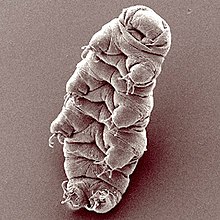Water bear
| Tardigrades Temporal range: Cambrian–Recent |
|
|---|---|
 |
|
| Hypsibius dujardini | |
| Scientific classification | |
| Kingdom: | Animalia |
| (unranked): | Tactopoda |
| Phylum: |
Tardigrada Spallanzani, 1777 |
| Classes | |
Tardigrades (/ˈtɑːrdᵻˌɡreɪd/; also known as water bears, space bears, pudgy wudgies, or moss piglets) are water-dwelling, eight-legged, segmented micro-animals. They were first discovered by the German zoologist Johann August Ephraim Goeze in 1773. The name Tardigrada (meaning "slow stepper") was given three years later by the Italian biologist Lazzaro Spallanzani. They have been found everywhere from mountaintops to the deep sea, mud volcanoes, and from tropical rain forests to the Antarctic.
Tardigrades are one of the most resilient animals known: they can survive extreme conditions that would be rapidly fatal to nearly all other known life forms. They can withstand temperature ranges from 1 K (−458 °F; −272 °C) (close to absolute zero) to about 420 K (300 °F; 150 °C) for several minutes, pressures about six times greater than those found in the deepest ocean trenches, ionizing radiation at doses hundreds of times higher than the lethal dose for a human, and the vacuum of outer space. They can go without food or water for more than 30 years, drying out to the point where they are 3% or less water, only to rehydrate, forage, and reproduce. Tardigrades living in harsh conditions undergo an annual cycle of cyclomorphosis.
They are not considered extremophilic because they are not adapted to exploit these conditions. This means that their chances of dying increase the longer they are exposed to the extreme environments, whereas true extremophiles thrive in a physically or geochemically extreme environment that would harm most other organisms.
...
Wikipedia
